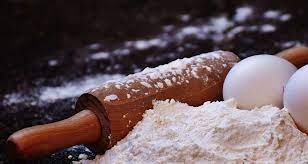Elevate Your Baking Game with the Right Flour

Flour is the foundation of baking, and choosing the right type can make all the difference in your baked goods. Whether you’re a seasoned baker or just starting, understanding the various types of flour and how to use them can unlock a world of possibilities in the kitchen.
Get ready to take your baking skills to new heights!
Understanding Different Types of Flour
All-purpose flour:
The versatile choice for many recipes, all-purpose flour is a blend of hard and soft wheat. It works well in various baked goods, from cookies to muffins.
Bread flour:
With a higher protein content, bread flour is ideal for yeast-based recipes like bread and pizza dough. Its gluten development provides the desired texture and structure.
Cake flour:
Cake flour has a lower protein content and is finely milled, resulting in a tender crumb. It’s perfect for light and fluffy cakes, cupcakes, and other delicate pastries.
Pastry flour:
Similar to cake flour, pastry flour has a lower protein content but with slightly more gluten. It balances tenderness and structure, making it great for pies, tarts, and cookies.
Whole wheat flour:
Made from grinding entire wheat kernels, this flour contains the bran, germ, and endosperm. It adds a nutty flavor and extra nutrients to baked goods, such as bread and muffins.
Gluten-free flour alternatives:
For those with gluten sensitivities or dietary restrictions, there are various gluten-free flour available, such as almond flour, rice flour, and chickpea flour. These options allow you to enjoy delicious baked goods without compromising taste or texture.
Matching the Right Flour to the Right Baked Goods
Best flours for the pastry:
Pastry flour or a combination of all-purpose and cake flour works well for flaky and tender pastries, such as croissants or puff pastries.
Ideal flours for cake
For light and airy cakes, cake flour is the go-to choice. However, combining all-purpose flour with a small amount of cornstarch can also yield excellent results.
Perfect flours for pie
Pastry flour is often used for pie crusts, providing the right balance of tenderness and flakiness. You can also experiment with a blend of all-purpose and whole wheat flour for a heartier crust.
Recommended flours for bread
Bread flour is the top choice for yeast bread recipes. Its high protein content contributes to developing a chewy and well-structured loaf. However, you can also experiment with a combination of all-purpose and whole wheat flour for a different flavor and texture.
Storage Tips for Flour
Proper storage techniques
To maintain the quality of your flour, store it in a cool, dry place away from direct sunlight and heat sources.
Shelf life of different flours
While all-purpose and bread flours have a longer shelf life due to their higher protein content, cake, and whole wheat flour should be used within a few months for the best results.
Avoiding moisture and pests:
Keep your flour in a tightly sealed container to prevent moisture absorption and deter pantry pests from infesting your supply. Adding a bay leaf to the container can help repel bugs.
Nutritional content of different flours:
Whole wheat flour, almond flour, and other alternative flours offer more fiber, vitamins, and minerals than refined flours.
Gluten-free and alternative flours:
Gluten-free flours, such as rice flour and chickpea flour, provide options for individuals with gluten sensitivities or those following a gluten-free diet.
Flour options for dietary restrictions:
With the rise of nutritional conditions, flours are available that cater to specific needs, such as coconut flour for those following a low-carb or paleo diet.
Experimenting with different flours:
Incorporating a variety of flours, such as pounded yam flour, into your baking provides nutritional benefits and adds unique flavors and textures to your baked goods.
Flour Storage and Shelf Life
Proper flour storage and understanding its shelf life are essential for maintaining the quality and safety of this pantry staple. Flour is a versatile ingredient, but it’s not immune to factors affecting its freshness and usability.
To maximize flour’s shelf life, storing it in an airtight container, preferably in a cool, dark, and dry place, is crucial. Exposing flour to moisture or air can lead to the growth of mold or the development of an off-putting odor and taste. It’s also essential to keep flour away from strong-smelling items like
- spices,
- chemicals as it can easily absorb odors.
The shelf life of flour depends on its type and any added preservatives. All-purpose flour, for example, typically has a longer shelf life than whole wheat or specialty flour due to its lower oil content. Properly stored, all-purpose flour can last up to 1-2 years, while whole wheat flour has a shorter shelf life of about 6-8 months.
However, checking for signs of spoilage, such as a rotten smell, discoloration, or tiny pests, is essential. When in doubt, perform a sensory check before using it in recipes.




